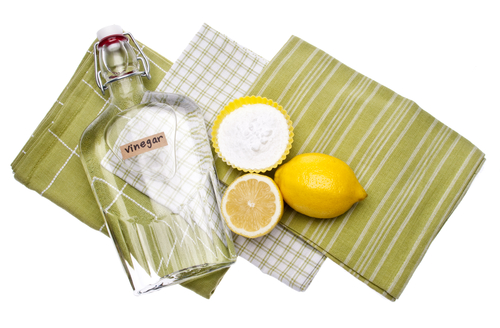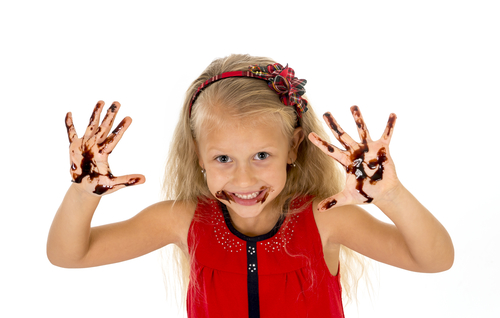Removing stains from clothes can now be done the natural way and limit the exposure to the chemicals contained in most commercial spot-cleaning products. How? Here is how to go green when removing stains from clothes with the use of the simplest things you can find in your kitchen or the nearest supermarket!
1. Baking Soda
Definitely one of the best things you can use to clean your home and remove odors from your fabrics. If used before the start of the wash cycle, it will boost the performance of your detergent and keep your laundry smelling super fresh and feeling soft to the touch. Plus, it’s cheap and safe to use on practically every piece of clothing, and this includes kids’ sleepwear! You will also notice that it reduces SUDS LOCK due to overuse of detergent during the wash cycle. More on the incredible uses of baking soda here!
2.Distilled White Vinegar
Particularly effective in treating underarm odors and yellowing. It is much safer to use than chlorine bleach because it contains acetic acid, which is gentler on fabrics, yet equally effective. With distilled white vinegar, you can also make your whites brighter, remove mildew, clean your silverware and washer, and many more!
3. Lemon Juice
Where should we begin? Besides the many health benefits that come with the consumption of lemon juice, it can be used to disinfect cutting boards, brighten clothes and areas in the home, remove rust stains, deodorize your garbage, get rid of stubborn stains on marble, and clean tarnished brass, to name just a few!
Here are more magical uses of lemon!
4. Table Salt
In the laundry, table salt can help as a mild abrasive element to get rid of red wine and rust stains. Also, it is used to help absorb liquid stains before they settle deep in the fabrics (just remember to wash it out to prevent white stains from setting on the fabric).
That aside, brushing your wicker furniture with a stiff brush dipped in warm salt water can help revert the harmful effects of sun exposure and any damage done over time (i.e. yellowing). And, we are just scratching the tip of a colossal iceberg now!
5. Cornstarch
Cornstarch, as well as baby powder, works wonders as natural treatments for greasy or oily stains. If you catch the stains early, you can even completely remove it. All you need to do is sprinkle the affected area with cornstarch until you feel it’s enough. Alternatively, you could rub with chalk and get the same fantastic results. Give cornstarch some time to sit on the stain for a few minutes. The more you leave it on, the more oil it absorbs. But, overall, 15-20 minutes should be enough for a small oily stain. Brush away and voila.
You can also polish silver, bust smells, fix leather stains, and more.
6. Household Borax
Borax is an element (naturally occurring) that’s very popular for its stain-removing properties. Many people use it to
-
Clean their carpets (½ cup of Borax/gallon of water used in carpet steaming cleaning machines).
-
Clean their toilet bowl (pour 1 cup of Borax and let it stay overnight).
-
Keep pests away (combine Borax and sugar in equal parts and sprinkle where you see fit).
-
Preserve fresh-cut flowers (2 parts corn meal and 1 part Borax in the vase)
-
Clean aluminum and porcelain cookware (sprinkle with Borax and rub with a soft cloth)
-
Deodorize the fridge (wash away spilled food with a solution of 1 tablespoon Borax in 1 quart of water).
7. Hydrogen Peroxide
Compared to chlorine bleach most of us use, hydrogen peroxide is much gentler on clothes, although it produces the same results with bleach. It is also effective when you want to remove red wine stains or curry stains.
That said, you can use it as a mouthwash, whiten your teeth and nails, as a deodorant, disinfect your countertops and cutting boards, whiten your grout, clean your mirrors, kill mold, keep a salad fresh and may many more!
One of the toughest stains to remove is chocolate, right? We’ve got some good news for you. Follow these easy and simple steps and treating chocolate stains will become a walk in the park!
How to Treat Chocolate Stains
1. First of all, remove as much excess chocolate from the fabric as possible with a spoon or butter knife. Be very careful when doing so because you don’t want to spread the chocolate to the surrounding clean parts. If you didn’t have the chance to treat the stain upon its birth and it has already dried onto the fabric, don’t try to scrape chunks of chocolate away, or you’ll damage the fibers. It’s better to…
2. Pre-treat the stain with a stain remover spray or gel. Treat both sides or rinse the back of the stained area with cold water (not warm or hot because this will allow the protein-based part and the oil-based components of the stains to set in).
3. Rub the stain with some laundry detergent (liquid). This will help break down the stain. Let it sit for a few minutes (5 mins will do) and then soak the piece in cold water for about 15 minutes without rinsing it clothing. Make sure you rub the stain between your finger every 5 minutes or so to help loosen the stain. Rinse and continue until the stain is completely removed.
4. Wash the clothing in the normal cycle. Check whether the stain is completely gone before drying.
Note: If the stain is left untreated for long, time combined with the heat of the washing machine will allow it to set, making it very difficult (to almost impossible) to remove. Most likely, they show up as dark blotches on the fabric. What you can try, though, is rub the affected area with some liquid dish soap or laundry detergent and soak the piece in cold water for an hour. Repeat, if the stain remains. Then wash the clothing with a product that doesn’t contain chlorine bleach (i.e. Oxiclean). For whites, you can use lemon juice to treat the stain or any commercial product with mild bleaching properties. Rinse well and wash.


